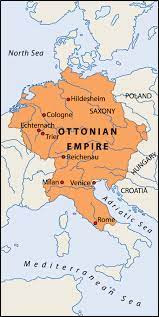Richard of Cornwall (1209 - 2 April 1272) was the second son of King John. When Richard was eight years old, he was made High Sheriff of Berkshire; eight years later he was Count of Poitou, and also made Count of Cornwall as a birthday present from his older brother, King Henry III. As seemed to happen often in English royal families, relatives rebelled against the king, and Richard rebelled three times against Henry.
Skipping a bit (quite a bit, like three wives, rebellions, building a castle at Tintagel, a Crusade, and several legitimate and illegitimate children), we come to 1257, when four of the seven German Electoral Princes (those who had the privilege of choosing the ruler of the Holy Roman Empire) chose him to be King of Germany (see a 1341 illustration of the seven above). There was opposition: three of the electors voted for Alfonso X of Castile (a successful and respected ruler, but one who had never set foot in Germany), who was also supported by King Louis IX "the Saint" of France and Pope Alexander IV. Louis and Alexander were eventually won over by Richard's sister-in-law, Eleanor of Provence, and by Eleanor's sister, Richard's second wife. She was Sanchia of Provence, daughter of Ramon Berenguer IV, Count of Provence, and Beatrice of Savoy. Sanchia's and Eleanor's sister Margaret was married to Louis IX.
One of the seven electors was Ottokar II of Bohemia, who voted for Richard, changed his support to Alfonso, then changed his vote to Richard after being bribed, giving Richard the majority. In all, the position cost Richard 28,000 marks to gain support of the four electors needed for a simple majority.
Richard treated the position as honorary. King of Germany at this point was equivalent to Holy Roman Emperor, and also called "King of the Romans." Richard only made four brief visits to Germany, spending most of his time in England, supporting his brother Henry in the Second Barons War. At the Battle of Lewes, he hid in a windmill, but was discovered and imprisoned until September 1265.
In December 1271 he had a stroke that paralyzed his right side and cost him the ability to speak. He died on 2 April 1272 and was buried next to Sanchia at Hailes Abbey, which he founded.
The powerful families in and around Germany had spread and splintered, and no powerful and obvious candidates for King of the Romans stood out. Ottokar II of Bohemia sought the position, as did Rudolf I of Habsburg, but neither prevailed for almost 20 years, until the Second Council of Lyon selected Rudolf.
Tomorrow we'll see if we can figure out why Rudolf was chosen over Ottokar. It will be Christmas Day, but the quest for knowledge doesn't take a holiday.







